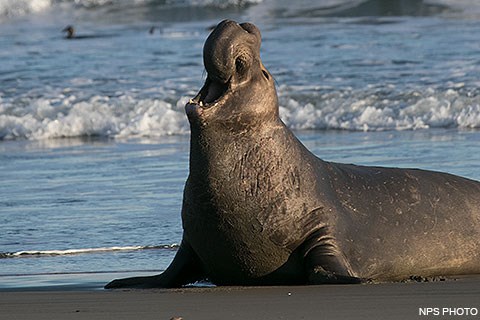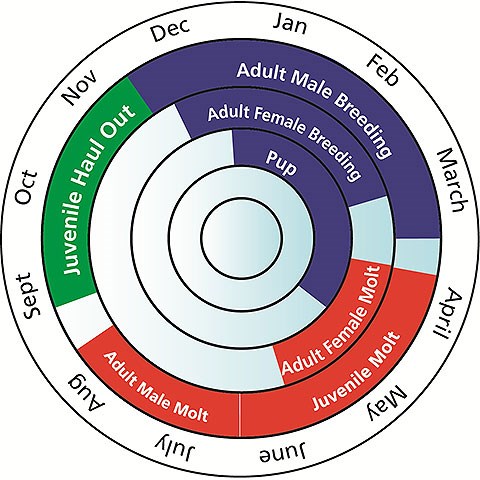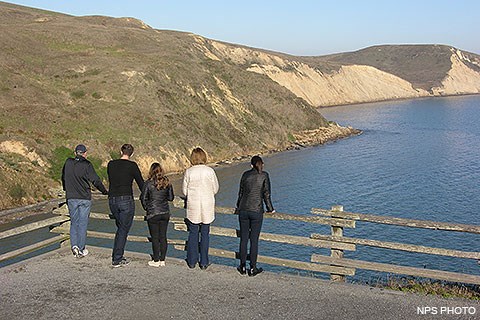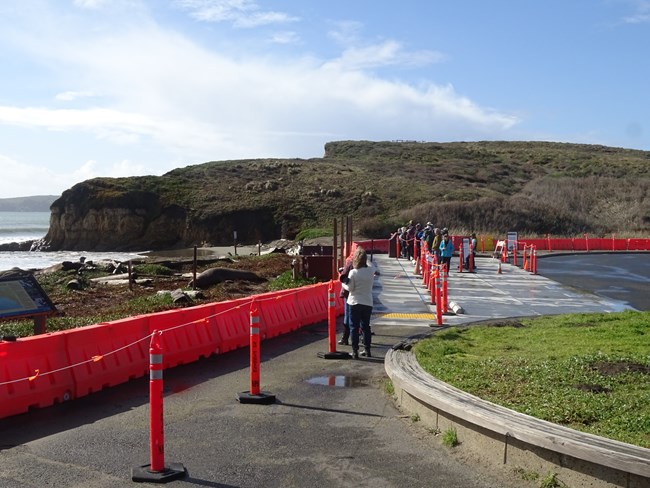
A Brief History of Elephant Seals at Point ReyesAfter being absent for more than 150 years, northern elephant seals returned to sandy pocket beaches on the south side of the Point Reyes Headlands in the early 1970s. In 1981, the first breeding pair was discovered near Chimney Rock. Between 1988 and 1993, the population grew at a dramatic annual average rate of 32%. Since 1993, the average growth rate has slowed to 8–9% per year. Fanning out from their initial secluded south-facing beaches of the headlands, the seals have since expanded to beaches which are not as remote, including, after 2019, Drakes Beach adjacent to the Kenneth C. Patrick Visitor Center. 
When are Elephant Seals Present at Point Reyes?While some elephant seals may be present at Point Reyes on any given day of the year, the greatest number of seals haul out on beaches around the headlands from December through March for the birthing and mating season, and in the spring when adult females and juveniles haul out to molt. Visitors may observe a colony of elephant seals from the Elephant Seal Overlook near Chimney Rock, above beautiful Drakes Bay, or from the South Beach Overlook a short distance north of the Point Reyes Lighthouse visitors' parking lot. And, since 2019, visitors are also able to view a colony on the beach adjacent to the Kenneth C. Patrick Visitor Center. The males are the first to arrive here, in December, in an effort to stake out a claim on the beach they hope to dominate. Then pregnant females begin to arrive and, soon thereafter, give birth to a single pup. 
Elephant Seal OverlookFrom the Elephant Seal Overlook, you can witness the fascinating behavior of these animals, including male dominance contests, birthing of pups, and the interactions of mothers and pups. You will hear the distinctive vocalizations of females and pups, as well as the powerful trumpeting of the adult males (referred to as "bulls"), which can be heard for over a mile. After a month of nursing, female elephant seals will wean their pups and head back out to sea for a month or two of feeding to replenish deleted energy reserves, leaving the weaned pups ("weanlings" or "weaners") to survive on their own. Once adult females have left the colonies, adult males will also depart. By mid-April, most of the pups have left the area to find food. In early April, juvenile seals and adult females come to shore for four to six weeks in order to molt (shed their skin). Toward the end of the spring, the female molt has concluded and they head back to sea for a longer feeding period. The juvenile molt extends into early summer when the adult males start to haul out for their molting season. There tend to be very few elephant seals at Point Reyes in the late summer, but on most days a few elephant seals may still be seen from the Elephant Seal Overlook. By mid-September, juveniles will return to shore for a resting haul out. During this time, the juvenile seals are still growing and being onshore allows their bones and muscles to develop properly. It also gets them in sync with the coming on shore twice a year pattern and allows the seals to do this before the breeding season, in which they are too young to participate. Check out our Weekly Elephant Seal updates to learn the latest news. 
Elephant Seals at Drakes BeachLast updated: December 4th, 2025 The beach to the southwest (e.g., towards Chimney Rock; to the right as one faces the bay) of the Drakes Beach parking lot is always closed to all entry from December 15 through mid-June (see Interactive Map below.) History of Elephant Seals at Drakes BeachSince winter 2018–2019, male elephant seals have returned to Drakes Beach adjacent to the Kenneth C. Patrick Visitor Center in early December and pregnant females have returned to the beach in late January to give birth to their pups. As a result, to better protect the elephant seals, the park has closed access to Drakes Beach, and, at times, the entire Drakes Beach area, to the public for varying lengths of time. Please be aware that closures may be implemented at any time of the year if elephant seals return in large numbers. These closures were necessary to protect human and seal safety. To view the larger elephant seal colony that is further southwest along Drakes Beach, please visit the Elephant Seal Overlook near Chimney Rock. Peter Behr OverlookThe Peter Behr Overlook may be reached by following a steep, narrow paved path from the southwest corner of the parking lot to a bluff-top viewpoint. It offers a great view of Drakes Bay, Chimney Rock, and Drakes Beach to the east…but not much of a view of the section of beach to the west on which most of the elephant seals are hauled out. For your safety, and the safety of the seals on the beach below, please stay on the paved path and do not go over or around the wooden fencing at the end of the paved trail. Loose soil and/or rock along the blufftops can give way suddenly and you may fall. Or you might initiate a rockfall or landslide that injures or kills the seals on the beach below. Also, there is a lot of poison oak growing among the vegetation surrounding the trail and overlook. Please note: The Peter Behr Overlook and trail will be closed any time Drakes Beach is closed. Seal viewing tips
Feeding or Harassing Marine Mammals in the Wild is Illegal and Harmful to the AnimalsWhy is it illegal to feed, attempt to feed, or harass marine mammals in the wild?Feeding, attempting to feed, and harassment of marine mammals in the wild by anyone is prohibited by regulations enacted under the Marine Mammal Protection Act. Feeding, attempting to feed, or otherwise harassing marine mammals in the wild was made illegal because it is harmful to the animals in the following ways:
How is "harassment" defined under the Marine Mammal Protection Act?Harassment means any act of pursuit, torment, or annoyance that has the potential to injure a marine mammal or marine mammal stock in the wild (Level A harassment); or that has the potential to disturb a marine mammal or marine mammal stock in the wild by causing disruption of behavioral patterns, including, but not limited to, migration, breathing, nursing, breeding, feeding, or sheltering, but does not have the potential to injure a marine mammal or marine mammal stock in the wild (Level B harassment). More information on this topic may be found on the National Marine Fisheries Service's Frequent Questions – Feeding or Harassing Marine Mammals in the Wild page. Elephant Seal Protection Areas:Download the Elephant Seal Protection Closures Map, which shows the areas that are affected by the year-round and/or seasonal closures described below. (1,179 KB PDF) Drakes Beach Elephant Seal Colony Year-Round ClosureThe Drakes Beach elephant seal colony as delineated by signs at the western-most end of Drakes Beach is closed to all entry due to seal activity at all times of the year. This closure is necessary to protect an established elephant seal colony from disturbance and protect the public. The elephant seal colony is used all year. No management action other than a year-round closure is sufficient. Annual Seasonal Closures:From December 15 to mid-June, the following areas are closed to all entry in order to better protect nursing elephant seal pups and molting seals:
From December 15 to March 31, the following areas are closed to all entry in order to better protect nursing elephant seal pups:
Interactive Map Illustrating the Locations of the Closures Referenced AboveLearn MoreDuring weekends and holidays, highly trained docents staff the Elephant Seal Overlook and Drakes Beach. They have binoculars, spotting scopes, and a wealth of information to share with you. Check out our Elephant Seals page, the Pacific Coast Science and Learning Center's Elephant Seals web page, or our Elephant Seals Resource Newsletter (1,338 KB PDF).
| |
Last updated: December 4, 2025
